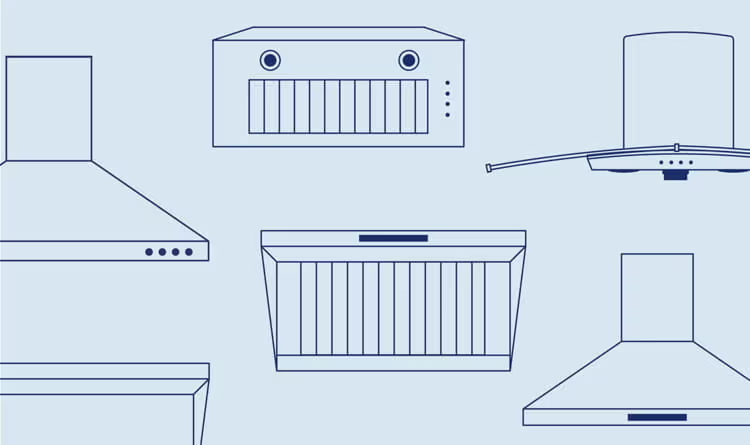Buyer’s Guide: 6 Simple Steps to Choosing the Right Range Hood

Figuring out how to choose a range hood may seem overwhelming at first—but it’s actually very simple and straightforward once you understand the terminology and how it all works.
That’s why Hauslane put together this short, handy guide.
Why Does Choosing the Right Range Hood Matter?
Shopping for a kitchen hood is a much bigger decision than buying, say, an inexpensive kitchen knife. You could probably select a knife from a catalog based on appearance alone, and in most cases it will do its job of slicing, dicing, and prepping food. Eventually, the blades will get dull and you’ll replace it. That’s simply not how things work with range hoods.
If the hood’s fan isn’t powerful enough for your stove burners, smoke and odor will linger, impacting your home’s air quality. Moreover, compatibility with your ductwork is crucial for installation. Understanding how to choose a range hood is essential for ensuring your kitchen functions optimally.
Investing in a range hood is crucial, as the right choice can serve you for many years, even decades. Quality range hoods are durable and enhance your cooking experience, providing value for money.
Step 1: Learn the Difference Between Ducted Vs. Ductless Ventilation
An air duct is a broad metal conduit that enables your blower to expel cooking smoke from your home to the outside.
Ducted Range Hoods connect to air ducts in your kitchen, enabling the blower to draw in and expel smoke, odor, and grease outside.
Ductless Range Hoods utilize charcoal filters to trap grease, odor, and debris before circulating the air back into the home.
Ducted/Ductless Range Hoods incorporate both technologies, providing flexibility for installation in any kitchen. Many of our range hoods offer the option to operate as either ducted or ductless units, depending on your requirements.
Why go ductless?
Some kitchens lack pre-existing ductwork, especially if the cooktop isn’t near an exterior wall. In such cases, choosing a unit with ductless capabilities is essential.
You might also select a ductless model for its versatility. For instance, during remodeling, if you relocate the stove to a spot away from existing ductwork, ductless models eliminate the need for ducting modifications.
Why go ducted?
If your kitchen already has ducts conveniently located, a ducted range hood may be preferable. It efficiently removes grease particles and cooking fumes.
Ducted range hoods enable the installation of a more powerful blower, which is beneficial for larger kitchens or professional-grade ranges that generate substantial smoke at maximum capacity.
Step 2: Select Your Mounting Style
Now it’s time to determine the location and method of mounting your range hood. When considering how to choose a range hood, you have four primary mounting options: under the cabinet, against the wall, directly into the ceiling (island), or recessed (inside the wall or cabinet). Here’s an overview of each of these options.
1. Under the Cabinet
These range hoods are designed to fit directly beneath a cabinet, concealing the ductwork within the cabinet structure. You can choose from three under-the-cabinet styles to suit your kitchen’s layout.
Slim Style: With a height of less than 10 inches, these sleek range hoods are ideal for smaller, more compact kitchens.
Pro Style: While larger in size, these range hoods typically feature powerful blowers, making them suitable for chefs who use high-capacity burners that produce significant smoke.
Microwave: Many customers initially opt for microwave range hoods, which are connected to existing microwaves, before upgrading to our products. These range hoods use standard duct sizes, typically 3-¼” x 10”, and vent from the back, connecting to short ductwork leading outside through the home’s exterior wall.
2. Against the Wall
These units are positioned directly against the wall, with ductwork connecting behind the chimney cover. This mounting option is suitable if your range is not located below any cabinets.
Island
For island stoves, island range hoods can be mounted from the ceiling, hanging directly over the cooktop. Island range hoods are typically larger and equipped with more powerful blowers.
Why the need for more power? Unlike units under cabinets or against walls, island range hoods must contend with air currents from multiple directions. The increased power and broader surface area of island-mounted range hoods help prevent smoke and odor from spreading throughout the kitchen.
3. Recessed/Built-in
These units are recessed into the wall to optimize space usage and can be installed inside a standard cabinet or the chimney itself.
Step 3: Understanding Your Grease Filters
Grease filters play a crucial role in capturing and eliminating grease and other particles carried in smoke. There are four distinct types of grease filters: mesh filters, baffle filters, hybrid filters, and charcoal filters.
Baffle Filters: These advanced filters utilize a specialized design to impede smoke flow and capture pollutants effectively. They are reusable, dishwasher safe, exceptionally durable, and widely regarded as the standard for efficiency in the industry.
Mesh Filters: Grease is trapped in aluminum mesh filters. They are cost-effective and reusable but require regular cleaning to maintain efficiency.
Hybrid Filters: Hybrid filters combine the characteristics of both mesh and baffle designs.
Charcoal Filters: Essential for ductless range hoods, charcoal filters require periodic replacement. While they are less efficient compared to other designs, they are lightweight and easy to replace.
Step 4: Find the Right Blower Strength for Your Needs
The blower plays a vital role as the powerhouse of your range hood. Without the appropriate blower size tailored to your needs, your range hood may struggle to effectively eliminate smoke, grease, and odor from your home.
Blower strength is quantified by its capacity to move a specific volume of air within a set timeframe, known as Cubic Feet per Minute (CFM). The CFM capacity of each range hood is clearly listed. Blowers exceeding 900 CFM are considered professional grade and are suitable for serious chefs. Discover how to determine the ideal CFM for your kitchen here.
How to Determine the Minimum CFM Requirements for Your Stove
Electric Stoves: The CFM requirements for electric stoves are determined by the width of the range. Measure the width of your range, and for every inch, you’ll need 10 CFMs.
Gas Stoves: The minimum CFM requirements for gas stoves are based on British Thermal Units (BTUs). BTUs measure how quickly water temperature can be raised when the burner is at maximum capacity.
Going Beyond ‘Good Enough’: These figures represent the minimum necessary for a blower to perform its function. However, why settle for just ‘good enough’?
Blowers in range hoods approach or exceed professional grade standards, ensuring a healthy, smoke and odor-free environment, even when the cooktop is operating at maximum capacity. When deciding on a range hood for your kitchen, opt for premium products that offer the power and effectiveness you desire.
Why limit yourself as a chef? Choose products that provide an exceptional experience at a reasonable price.
Step 5:Choosing the Right Size Unit
Different mounting configurations necessitate varying unit sizes, determined by the width of the stove.
Under Cabinet and Wall Mounted Units: Range hoods should match or slightly exceed the width of the stovetop.
Example: A 36-inch-wide cooktop requires a range hood of at least 36 inches wide.
Island Units: Island units should be slightly larger than cabinet and wall mounted units to account for cross-currents. To effectively capture smoke before it disperses, these units should extend 3-6 inches beyond the range on both sides.
Example: A 36-inch-wide cooktop necessitates a range hood of 42 inches.
Height Requirements for All Units: Range hoods should be installed 24-30 inches above the stovetop. This information helps determine the required height of the range hood for proper ductwork connection.
Step 6: Understanding Additional Features
Products offer a range of features to suit different budgets, including auto-cleaning, delayed shut-off, specialized lighting, and multiple fan speed settings.
Auto-cleaning: Certain range hoods feature auto-cleaning functionality, utilizing steam-cleaning or water-cleaning technology to remove grease buildup from the motor, fan wheel, and housing. This improves hygiene, prolongs motor life, and maintains long-term efficiency, ensuring consistent suction power over time.
Delayed Shut-off: Delayed shut-off allows the fan to continue running for a period after cooking is finished, eliminating lingering smoke. Simply press a button and let it shut off automatically.
Lighting: Consider the lighting options available. GU10-LED lights offer energy efficiency and easy replacement. Integrated LED lighting lasts longer but may be more challenging to replace. Halogen lighting provides bright illumination but offers minimal energy savings.
Speed Settings: Evaluate the range of speed settings for the fan. Some models offer multiple speeds, allowing you to find the ideal balance between noise level, power, and efficiency.
Passion for cooking drives our commitment to delivering professional-grade equipment for everyday use at an accessible price point. For further assistance in selecting a range hood, reach out to industry professionals for guidance.


















